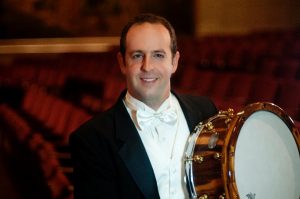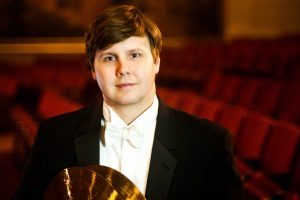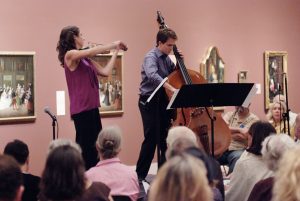Art of Elan Offers Probing Shostakovich and New Works at the San Diego Museum of Art
Thinking about that crazy-quilt repertory of 20th-century chamber music, the popular examples come quickly to mind: the middle movement of Samuel Barber’s String quartet that morphed into his iconic “Adagio for Strings” or Francis Poulenc’s giddily effervescent Flute Sonata. But a handful of deeper, striking works set the bar extremely high: the last three quartets of Béla Bartók, Messiaen’s “Quartet for the End of Time,” and Dmitri Shostakovich’s String Quartet No 8 in D Minor.
Art of Élan featured a gripping account of the Shostakovich String Quartet No. 8 Tuesday, March 27, in its concert at the San Diego Museum of Art. From the opening movement’s brooding introspection to the vibrantly brutal Allegro molto, these players revealed both the composer’s confessional angst of working under repressive Soviet ideology and the stunning architectural feats his fertile imagination could construct. First violinist Wesley Precourt soared both in plangent laments and those manic folkloric tunes and dances that Shostakovich confected with ironic verisimilitude.Violist Caterina Longhi’s driving, muscular playing stood out in the Allegro molto, a telling foil to cellist Andrew Hayhurst’s eerily dulcet themes so deftly executed in the cello’s highest range. Violinist Hanah Stuart engaged in svelte, intertwining cantabile lines with Precourt in the Allegretto. Performing with immaculately balanced ensemble in the center of the room—the audience tightly encircling the quartet —gave the listeners astonishing access to the turbulent power of this work.
“The Light that Fills the World,” John Luther Adams’ gently hovering tone poem that evoked the snowy
winterscapes of the composer’s native Alaska, opened this concert. A sextet of Igor Pandurski and Rose Lombardo on digital keyboard, Gregory Cohen on marimba, Andrew Watkins on vibraphone, Jeremy Kurtz-Harris on contrabass, and Wesley Precourt on violin crafted sustained, glacially moving chords that often changed only one note at a time. Although I am tempted to describe Adams’ style as Messaien without the bird calls, his music is actually gentler and less harmonically dense than that of the great French mystic. Constant quiet tremolandos from the percussion and an opaque organ-like sound from the keyboard provided a floating texture to this work, while the strings prodded gentle forward motion.When is the last time you heard a duet for contrabass and cello? Cleverly filling in this musical lacuna, Matthew Aucoin’s “Dual” dared the listener not to pay rapt attention to this unusual feat. Hayhurst and Kurtz-Harris turned out salvos of whirring, rapidly undulating close intervals, suggesting that “Duel” might have been a more apt title. Only the cello was given the occasional shapely melodic sigh, but each player brandished equal panache executing Aucoin’s clever etude. The young American Aucoin appears to be popping up everywhere—the Los Angeles is staging his opera “Crossing” in May as part of its L.A. Opera Off Grand series.
Before the concert began, Cohen and Watkins played a free concert appetizer in front of the museum adjacent to Lynn Russell Chadwick’s impressive brone sculpture “The Watchers.” Each percussionist played a skillful transcription of a J. S. Bach solo violin movement on marimba, followed by a drumming duet titled “Faded Lines” by Andrea Benet. While my brain was attempting to make sense of this percussion piece, a three-year-old youngster let go of his mother’s hand and improvised a spirited dance to the music. He had the right idea and was giving the music a far better response than I could hope to formulate. He got it!



